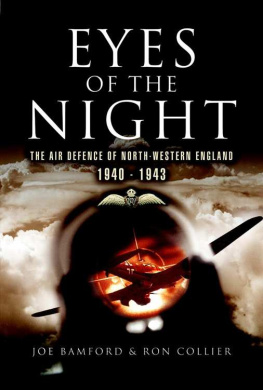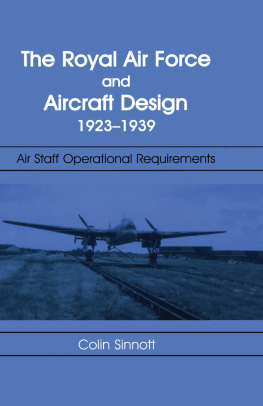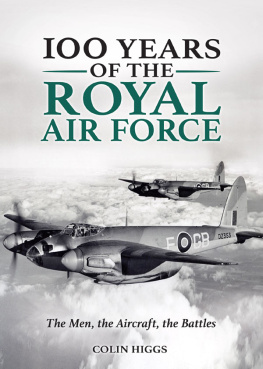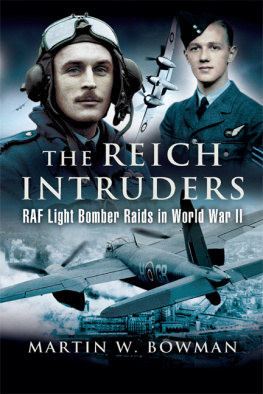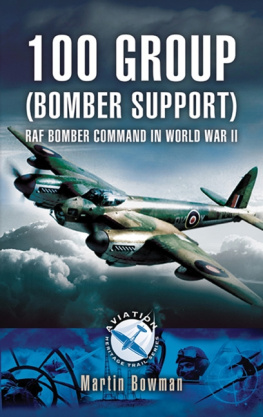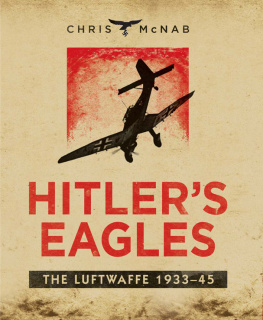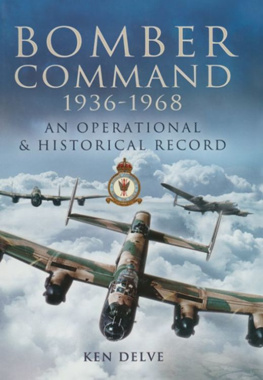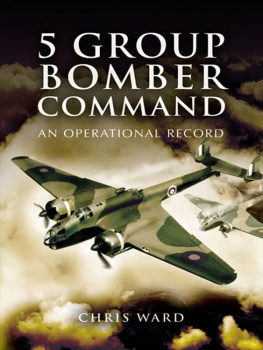The right of Joe Bamford & Ron Collier to be identified as the Authors of this Work has been asserted by them in accordance with the Copyright, Designs and Patents Act 1988.
A CIP record for this book is available from the British Library.
All rights reserved. No part of this book may be reproduced or transmitted in any form or by any means, electronic or mechanical including photocopying, recording or by any information storage and retrieval system, without permission from the Publisher in writing.
Typeset in the UK by Mac Style, Nafferton, E. Yorkshire.
Printed and bound in the UK by CPI UK.
Pen & Sword Books Ltd incorporates the imprints of Pen & Sword Aviation, Pen & Sword Maritime, Pen & Sword Military, Wharncliffe Local History, Pen & Sword Select, Pen & Sword Military Classics and Leo Cooper.
Foreword
This book is the result of extensive research by aviation archaeologist and Dark Peaks author Ron Collier. Many years ago Ron made contact with a number of wartime pilots, some of whom passed away a long time ago. Their anecdotes and recollections of the war form part of what is a unique story about Britains night defences in the north-west during the period 1940 3. My contribution has been to follow up Rons research and establish fresh contacts with former 9 Group personnal.
Eyes of the Night is primarily the story of 9 Group, Royal Air Force Fighter Command, which was specifically formed for the protection of Liverpool and Manchester during its darkest hour. It gives a detailed account of the air defence organization which was built up to protect north-west England but it is especially concerned with the Royal Air Forces night-fighter operations. The story includes accounts of combats which took place around the region and tells of the fate of Allied and German aircrew who were involved in such actions.
What is different about this book is that it also contains details of those incidents involving pilots and airmen who were killed or injured on non-operational flights. While 9 Groups squadrons lost only a handful of aircrew to enemy action, a large number were killed during training. They are generally the forgotten ones but the authors recognize their courage and contributions to the night air-war.
Many of those who died were young New Zealanders who had travelled halfway around the world to fight for their Mother Country and the Empire. Because of the lack of equipment and outdated training methods, a significant number were killed even before they got the chance to take part in operations. This book documents the triumphs and the tragedies of 9 Group and it is dedicated to all those who were killed, regardless of the circumstances.
The authors owe a great deal to Russell Brown, Brian Wild, Eric Raybould, John MacDonald, Dave Sanderson, Tom Smith, Stan Walker, Clem Lea, Norman Hurst, Tony Harratt, Graham Berry and Edwin Booth of Booths Supermarkets. Without their contributions and enthusiasm this book would never have been possible and a period of RAF history might have been forgotten. Others who have supported the project and donated additional material include aviation historians and authors Harry Holmes and Frank Cheesman. We also appreciate the support and help given by Mr Peter Turner and John Williams of the Manston Spitfire & Hurricane Memorial Building.
Thanks also to Derek Pratt and Michael Grant for permission to use some of their diagrams of 9 Group. There are probably many others not named here who have been involved at some stage or other and I sincerely apologize to anyone I have not mentioned.
Joe Bamford
CHAPTER ONE
Provisions for Air Defence: 1936 40
In 1939, when Britain declared war on Germany, most people failed to realize just how unprepared the air defences were in the regions outside London. The north-west of England was particularly badly organized and on Merseyside there were serious shortages of all kinds of vital equipment. Local politicians were well aware of the situation and a number of councillors had repeatedly warned the Government about the poor air-defence situation.
Open criticism included an article written by the Editor of the Liverpolitan magazine in May 1938, who claimed that not a single air-raid siren existed in the city. The reason for that, he said, was that the Government had refused to authorize a particular type or make. There were other shortfalls as well; of the 2,500 air-raid wardens required, fewer than 1,200 had been enrolled. Only half of those had received any training and in the event of an air attack the situation would be bleak.
The Editor also claimed that there were only four heavy anti-aircraft (AA) guns in Liverpool capable of hitting a target at 21,000 ft. The 1937 Air Defence Plan for the distribution of heavy AA allocated just forty guns to the defence of the whole of Merseyside. That was a huge shortfall compared to the fifty-six allocated to Manchester and the eighty to Birmingham and Coventry, and just a fraction of the 224 distributed around London. Setbacks in production and modifications to the 3.7 and 4.5 in guns caused lengthy delays in their allocation.
Both Liverpool and Manchester came under the control of the 4th AA Division which was part of the 2nd AA Corps that also covered the North Midlands. On the outbreak of war the 4th AA Division had just ninety-two heavy and twenty-six light AA guns to protect some of the countrys most heavily industrialized areas. Despite the earlier estimates of 1937, by June 1940 Liverpool had just sixteen heavy 4.5 in AA guns, supported by twenty-four 3.7 in guns, of which all but four were mobile. Manchester also had sixteen 4.5 in guns but a smaller number of 3.7 in guns, which were all static.
Apart from the shortage of armaments and manpower, Liverpool and Manchester remained vulnerable because they were not covered by the radar (RDF) network. While there were nineteen radar stations down the east coast of Britain there was not a single operational site north of Strumble Head in South Wales. There were a number of experimental stations under development on the Isle of Man and others at various locations along the coast of North Wales. Officially titled Air Ministry Experimental Stations (AMES), the sites on the Isle of Man at Bride (AMES No. 62) and Scarlett (AMES No. 63) would not be declared fully operational for another year.
The one concession to technology was that some AA units in Liverpool, such as 33 AA Brigade, were equipped with gun laying (GL) radar Mk 1. GL radar was capable of detecting targets at a range of 17 miles and the data it received was fed through to the predictors which guided the guns. The equipment may have been instrumental in the destruction of a Dornier 17 which was claimed by 33 Brigade on the night of 23/24 July.
The cover given by GL sets in the north-west was quite limited and in most areas AA units had to rely on mobile sound locators operated by the armys Acoustics Corps. In most cases the sound locators proved to be quite useless because they were designed to detect the sound made by a large force of bombers. The sound made by the approach of a single raider or a small force of enemy bombers could not normally be detected.

